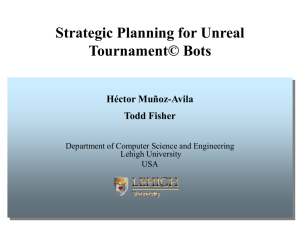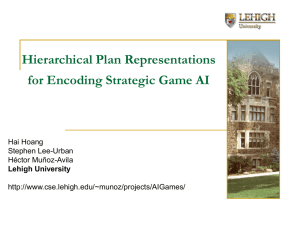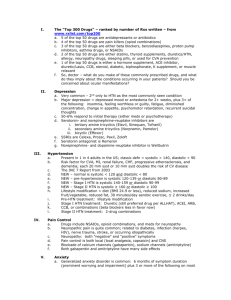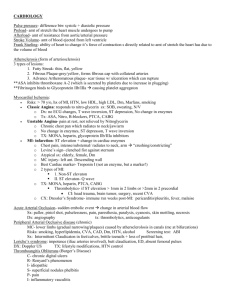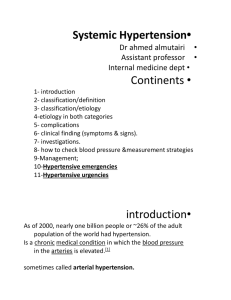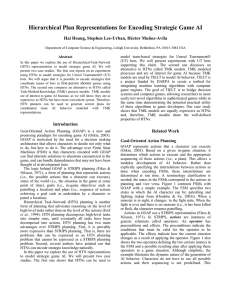HTNBots
advertisement
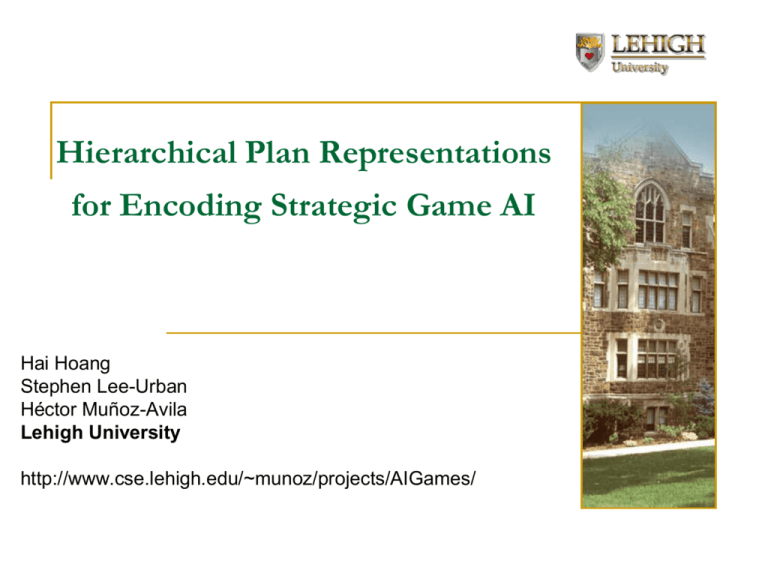
Hierarchical Plan Representations for Encoding Strategic Game AI Hai Hoang Stephen Lee-Urban Héctor Muñoz-Avila Lehigh University http://www.cse.lehigh.edu/~munoz/projects/AIGames/ Motivation for using HTN planning versus Standard (STRIPS) Planning Goal-Oriented Action Planning (Orkin, 2004, 2005) characters can find alternate solutions to situations encountered in the game Goals & characters can handle dependencies that may not have operators been thought of at development time HTNs provide distinct advantages over “STRIPS” planning, on which GOAP is based Key questions: What kinds of Game AI knowledge to represent in Game developers should HTNs? Learn LISP? How to reason in dynamic game environments? How to encode the HTNs Related Work: FPS and AI Games have the potential to become testbed for different AI algorithms (Laird & van Lent, 1999) FPS-based system developed and used for actual training of military personnel (Laird & Duchim, 2000) Soar Bots for UT using the Soar Architecture (Laird & Duchim, 2000) GameBots: A group at USC-ISI and CMU jointly developed the Gamebot project to create an API for other clients to connect to the UT server. Related Work: HTNs and Game AI Hierarchical planning can be useful in games (Wallace, 2003) Bridge Baron game uses HTN ideas (Smith et al., 1998) We will expand on this latter. Hierarchical FSMs are an extension of FSMs in which states can expand into their own sub-FSMs (Houlette & Fu, 2003) HTNs used for dialog generation (Cavazza & Charles, 2005) Unreal Tournament© Online FPS developed by Epic Games Inc. Various gameplay modes including team deathmatch and capture the flag Provides a client-server architecture for controlling bots High-level script language: UnrealScript (Sweeney, 2004) Client-Server Architecture for UT Bots The UT server provides sensory information about events in the UT world and controls all the gameplay events. Event-driven: The client program uses this information to decide commands controlling the behavior of a Bot and passes them to the server. Two types of messages: Asynchronous: special events Synchronous: regular intervals Variants: Enhanced server (USC/ISI), Java Bots (CMU), Soar Bots (U. of Michigan). Hierarchical Task Network (HTN) Planning Complex tasks are decomposed into simpler tasks. task t task t task t Seeks to decompose compound tasks into primitive tasks, which define actions changing the world The knowledge artifacts indicating how to decompose task into subtasks are called methods Hierarchical Task Network (HTN) Planning Principle: complex tasks are decomposed into simpler tasks. The goal is to decompose compound tasks into primitive tasks, which define actions changing the world. Travel(Lehigh,NRL) Travel from Lehigh to NRL alternative methods Travel by car Travel by plane Enough money for air fare available Enough money for gasoline Seats available Roads are passable Travel(Lehigh,Newark Airport) Drive(Lehigh, Newark Park) Bus(Newark Park,airport) Fly(Newark, BWI) Travel(BWI, NRL) Taxi(BWI, NRL) Task: travel(x,y) Method: taxi-travel(x,y) get-taxi ride(x,y) pay-driver Method: air-travel(x,y) get-ticket(a(x),a(y)) fly(a(x),a(y)) travel(a(y),y) travel(x,a(x)) HTN Planning travel(UMD, LAAS) get-ticket(BWI, TLS) go-to-travel-web-site find-flights(BWI,TLS) Problem reduction BACKTRACK Tasks (activities) rather than goals Methods to decompose tasks into subtasks Enforce constraints E.g., taxi not good for long distances Backtrack if necessary (slide from Dana S. Nau – University of Maryland) get-ticket(IAD, TLS) go-to-travel-web-site find-flights(IAD,TLS) buy-ticket(IAD,TLS) travel(UMD, IAD) get-taxi ride(UMD, IAD) pay-driver fly(BWI, Toulouse) travel(TLS, LAAS) get-taxi ride(TLS,Toulouse) pay-driver HTN Planning HTN planners may be domain-specific e.g., Bridge Baron Or they may be domain-configurable Domain-independent planning engine Domain description that defines not only the operators, but also the methods Problem description domain description, initial state, initial task network Task: travel(x,y) Method: taxi-travel(x,y) get-taxi ride(x,y) pay-driver Method: air-travel(x,y) get-ticket(a(x),a(y)) fly(a(x),a(y)) travel(x,a(x)) (slide from Dana S. Nau – University of Maryland) travel(a(y),y) Why HTN Planning (1)? HTN planning is provable more expressive than STRIPS planning (Erol et al, 1994) Even for those domains in which HTN representations can be translated into STRIPS representations, a much larger number of STRIPS operators is required to represent the HTN methods (Lotem & Nau, 2000) Fast planning through domain-configurable HTN planners (SHOP system) Why HTN Planning (2)? Potential for efficiency gains: Rather than searching through possible states and actions a top-down task decomposition process is performed that may prune the search space substantially Achieve 3-tower Pile 3rd block C B A A C B Achieve 2-tower Method: • Task: Achieve 3-tower(?A, ?B, ?C) • Subtasks: Achieve-2-tower(?B,?C), Piler-3rd-block(?A,?B) • Preconditions: on(?B,?C?), on(?C,?A) A B C A C A B A A B C B A B C A B C B C B C A A B C B C A C B A C Why HTN Planning (3)? Hierarchical planning is natural in many domains Military planning Strategic National Strategic Theater Operational Tactical JCS / NCA CINC JTF Application to Computer Bridge • Chess: better than all but the best humans • Bridge: worse than many good players • Why bridge is difficult for computers – It is an imperfect information game – Don’t know what cards the others have (except the dummy) – Many possible card distributions, so many possible moves • If we encode the additional moves as additional branches in the game tree, this increases the number of nodes exponentially – worst case: about 6x1044 leaf nodes 24 leaf nodes – Not average case: about 10 enough time to search the game tree (Dana S. Nau) How to Reduce the Size of the Game Tree? • Bridge is a game of planning – Declarer plans how to play the hand by combining various strategies (ruffing, finessing, etc.) – If a move doesn’t fit into a sensible strategy, then it probably doesn’t need to be considered • HTN approach for declarer play – Use HTN planning to generate a game tree in which each move corresponds to a different strategy, not a different card • Reduces average game-tree size to about 26,000 leaf nodes • Bridge Baron: implements HTN planning – Won the 1997 World Bridge Computer Challenge – All commercial versions of Bridge Baron since 1997 have include an HTN planner (has sold many thousands of copies) (Dana S. Nau) Another Application: UT Domination Games A number of fixed domination locations. When a team member steps into one of these locations, the status of the location changes to be under the control of his/her team. The team gets a point for every five seconds that each domination location remains under the control of that team. The game is won by the first team that gets a pre-specified amount of points. Idea Use of hierarchical task network (HTN) planning techniques to laid out a grand strategy to accomplish gaming tasks Use standard event-driven programming allowing the bots to react in highly dynamic environments while contributing to the grand task UT task: Domination Strategy: secure most locations UT action: move Bot1 to location B Technical Difficulties of using an HTN Planner (1) UT task: Domination Strategy: secure most locations UT action: move Bot1 to location B 2. Dealing with contingencies while Bots are executing actions 1. Declarative language for expressing conditions Solution to 1: use builtin predicates to represent conditions Solution to 2: use Java Bots to represent actions (the usual FSMs!) HTNBots: 3-layer Decision Making HTN planning layer: Which strategy to follow? HTN planning generates the strategy Input: task to perform (e.g., win a domination game), game events Output to next layer: specific tasks to individual bots (e.g., Bot “A” goes to domination location 2) FSM layer: how does each bot performs its task? FSM code the bots behavior Input: specific task to perform, game events Output to next layer: bots commands (e.g., attack) Game-engine layer: In charge of animation, passing events, pathfinding Input: bot command Output to previous layers: executed in game engine, game events (e.g., see an enemy) Data Flow in the HTN Planning Layer Selected method’s subtasks task compound? Yes Select applicable method Evaluate method’s preconditions No Execute action Method library UT Bot UT Bot … UT Server Video Empirical Results 60 50 40 30 HTN Improved 20 10 0 1 2 3 4 5 avg It is possible to encode strategies that coordinate teams of bots in FPS games using HTNs Final Remarks HTNs can be used to model effective team strategies for Unreal Tournament (UT) bots. A grand strategy is laid out by the HTNs and eventdriven programming allows the bots to react in this highly dynamic environment while contributing to the grand task. Three layer decision making that encompass: Strategy generation with HTN planning Individual bot behavior generation with FSMs Execution in game engine
